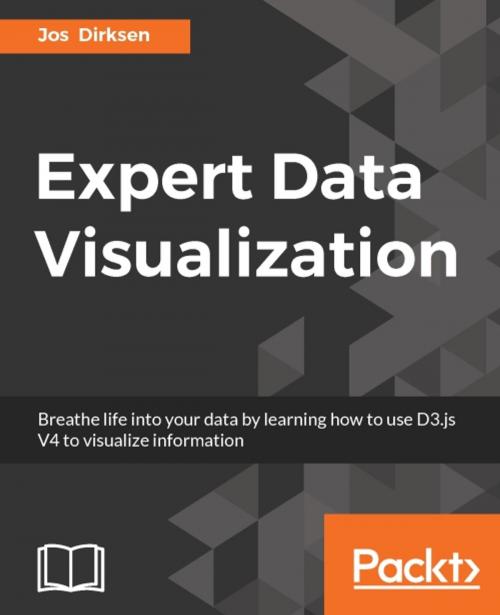Expert Data Visualization
Nonfiction, Computers, Programming, Programming Languages, CGI, JavaScript, Perl, VBScript, Internet, Web Development, Web Site Design| Author: | Jos Dirksen | ISBN: | 9781786466624 |
| Publisher: | Packt Publishing | Publication: | April 24, 2017 |
| Imprint: | Packt Publishing | Language: | English |
| Author: | Jos Dirksen |
| ISBN: | 9781786466624 |
| Publisher: | Packt Publishing |
| Publication: | April 24, 2017 |
| Imprint: | Packt Publishing |
| Language: | English |
Breathe life into your data by learning how to use D3.js V4 to visualize information
About This Book
- Create complex visualizations powered by D3.js and open data.
- Provides an extensive set of visualizations that explore all the functionality provided by D3.js V4.
- Shows how to set up an easy–to-use environment to create stunning visualizations.
Who This Book Is For
The typical target audience of this book is JavaScript developers, designers, and visual artists who have some basic JavaScript programming knowledge and who now want to master pro-level techniques to create interactive data visualizations using web standards which work on desktop as well as mobile devices.
What You Will Learn
- Learn how D3.js works to declaratively define visualizations.
- Create charts from scratch by using SVG and the D3.js APIs
- See how to prepare data for easy visualization using D3.js.
- Visualize hierarchical data using chart types provided by D3.js
- Explore the different options provided by D3.js to visualize linked data such as graphs.
- Spice up your visualizations by adding interactivity and animations.
- Learn how to use D3.js to visualize and interact with Geo- and Gis-related information sources.
- Create visualization by streaming data over WebSockets
In Detail
Do you want to make sense of your data? Do you want to create interactive charts, data trees, info-graphics, geospatial charts, and maps efficiently? This book is your ideal choice to master interactive data visualization with D3.js V4.
The book includes a number of extensive examples that to help you hone your skills with data visualization. Throughout nine chapters these examples will help you acquire a clear practical understanding of the various techniques, tools and functionality provided by D3.js. You will first setup your D3.JS development environment and learn the basic patterns needed to visualize your data. After that you will learn techniques to optimize different processes such as working with selections; animating data transitions; creating graps and charts, integrating external resources (static as well as streaming); visualizing information on maps; working with colors and scales; utilizing the different D3.js APIs; and much more. The book will also guide you through creating custom graphs and visualizations, and show you how to go from the raw data to beautiful visualizations. The extensive examples will include working with complex and realtime data streams, such as seismic data, geospatial data, scientific data, and more. Towards the end of the book, you will learn to add more functionality on top of D3.js by using it with other external libraries and integrating it with Ecmascript 6 and Typescript
Style and approach
This book will have a real–world, case-study approach, where you will be given data sets from different domains. These data sets will have different visualization goals; some might need 2D or 3D charts, some might need automated workflows, others might require interactive maps. While you fulfill these goals, you will learn different techniques and best practices, which will enable you to perform data visualization tasks on your own
Breathe life into your data by learning how to use D3.js V4 to visualize information
About This Book
- Create complex visualizations powered by D3.js and open data.
- Provides an extensive set of visualizations that explore all the functionality provided by D3.js V4.
- Shows how to set up an easy–to-use environment to create stunning visualizations.
Who This Book Is For
The typical target audience of this book is JavaScript developers, designers, and visual artists who have some basic JavaScript programming knowledge and who now want to master pro-level techniques to create interactive data visualizations using web standards which work on desktop as well as mobile devices.
What You Will Learn
- Learn how D3.js works to declaratively define visualizations.
- Create charts from scratch by using SVG and the D3.js APIs
- See how to prepare data for easy visualization using D3.js.
- Visualize hierarchical data using chart types provided by D3.js
- Explore the different options provided by D3.js to visualize linked data such as graphs.
- Spice up your visualizations by adding interactivity and animations.
- Learn how to use D3.js to visualize and interact with Geo- and Gis-related information sources.
- Create visualization by streaming data over WebSockets
In Detail
Do you want to make sense of your data? Do you want to create interactive charts, data trees, info-graphics, geospatial charts, and maps efficiently? This book is your ideal choice to master interactive data visualization with D3.js V4.
The book includes a number of extensive examples that to help you hone your skills with data visualization. Throughout nine chapters these examples will help you acquire a clear practical understanding of the various techniques, tools and functionality provided by D3.js. You will first setup your D3.JS development environment and learn the basic patterns needed to visualize your data. After that you will learn techniques to optimize different processes such as working with selections; animating data transitions; creating graps and charts, integrating external resources (static as well as streaming); visualizing information on maps; working with colors and scales; utilizing the different D3.js APIs; and much more. The book will also guide you through creating custom graphs and visualizations, and show you how to go from the raw data to beautiful visualizations. The extensive examples will include working with complex and realtime data streams, such as seismic data, geospatial data, scientific data, and more. Towards the end of the book, you will learn to add more functionality on top of D3.js by using it with other external libraries and integrating it with Ecmascript 6 and Typescript
Style and approach
This book will have a real–world, case-study approach, where you will be given data sets from different domains. These data sets will have different visualization goals; some might need 2D or 3D charts, some might need automated workflows, others might require interactive maps. While you fulfill these goals, you will learn different techniques and best practices, which will enable you to perform data visualization tasks on your own















